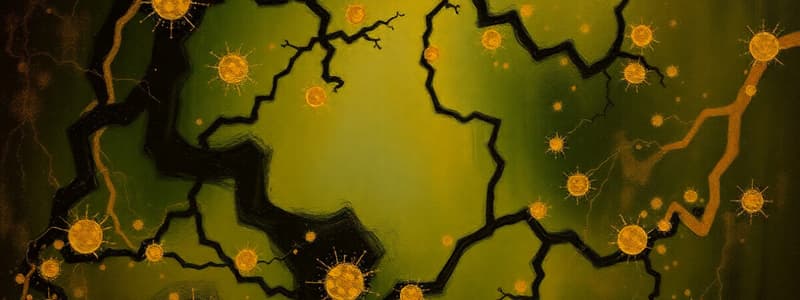Podcast
Questions and Answers
What condition can develop from long-term use of anthraquinones associated with a change in the colon lining?
What condition can develop from long-term use of anthraquinones associated with a change in the colon lining?
- Cirrhosis
- Crons Disease
- Melanesia coli (correct)
- Irritable bowel syndrome
Which of the following is a noted side effect of chronic anthraquinone use?
Which of the following is a noted side effect of chronic anthraquinone use?
- Diarrhea
- Hypokalemia (correct)
- Iron deficiency
- Gastroesophageal reflux
For how long is it considered unsafe to use laxatives containing anthraquinones?
For how long is it considered unsafe to use laxatives containing anthraquinones?
- More than two weeks
- More than one week (correct)
- More than three weeks
- More than one month
Which of the following could result from laxative dependence?
Which of the following could result from laxative dependence?
What are albuminuria and hematuria indicative of in the context of laxative use?
What are albuminuria and hematuria indicative of in the context of laxative use?
What are the main components of Sennoside A and B?
What are the main components of Sennoside A and B?
Which compound has the aglycone as Rhein?
Which compound has the aglycone as Rhein?
What type of glycosides are derived from anthrones in the leaves?
What type of glycosides are derived from anthrones in the leaves?
Which moieties are involved in the structure of dimeric anthracene glycosides?
Which moieties are involved in the structure of dimeric anthracene glycosides?
Which of the following is primarily found in the structure of Aloe-emodin anthrone?
Which of the following is primarily found in the structure of Aloe-emodin anthrone?
What distinguishes aloin A from aloin B?
What distinguishes aloin A from aloin B?
Which of the following is NOT a warning associated with the ingestion of Aloe preparations?
Which of the following is NOT a warning associated with the ingestion of Aloe preparations?
Which adverse effect is common with the use of Aloe preparations?
Which adverse effect is common with the use of Aloe preparations?
What severe reaction can occur as a result of Aloe preparations?
What severe reaction can occur as a result of Aloe preparations?
Which condition might result from Aloe ingestion due to loss of potassium?
Which condition might result from Aloe ingestion due to loss of potassium?
What is the primary form of application for the treatment of chronic eczema and psoriasis?
What is the primary form of application for the treatment of chronic eczema and psoriasis?
In addition to treating chronic eczema and psoriasis, what other use is mentioned for this substance?
In addition to treating chronic eczema and psoriasis, what other use is mentioned for this substance?
Which condition is NOT treated by the ointment mentioned?
Which condition is NOT treated by the ointment mentioned?
What is the main therapeutic function of the ointment in the context provided?
What is the main therapeutic function of the ointment in the context provided?
Which of the following is a characteristic feature of the conditions treated by the ointment?
Which of the following is a characteristic feature of the conditions treated by the ointment?
What is malic acid primarily known for in plants?
What is malic acid primarily known for in plants?
From which insect is carminic acid derived?
From which insect is carminic acid derived?
Which of the following correctly identifies carminic acid?
Which of the following correctly identifies carminic acid?
What is one of the specific code names for the pigment derived from carminic acid?
What is one of the specific code names for the pigment derived from carminic acid?
What percentage of the cochineal crude drug consists of carminic acid?
What percentage of the cochineal crude drug consists of carminic acid?
What type of compound is hypericin?
What type of compound is hypericin?
In which parts of the Hypericum perforatum plant is hypericin predominantly found?
In which parts of the Hypericum perforatum plant is hypericin predominantly found?
What is the primary color of hypericin?
What is the primary color of hypericin?
What structural form does hypericin exist as?
What structural form does hypericin exist as?
Which of the following statements about hypericin is correct?
Which of the following statements about hypericin is correct?
Flashcards
Long-term anthraquinone use
Long-term anthraquinone use
Prolonged use of anthraquinone-based laxatives might cause significant side effects.
Melanosis coli
Melanosis coli
A condition where colon lining darkens, potentially increasing cancer risk.
Anthraquinone laxative safety
Anthraquinone laxative safety
Avoid using anthraquinone laxatives for over a week.
Laxative dependence
Laxative dependence
Signup and view all the flashcards
Hypokalemia
Hypokalemia
Signup and view all the flashcards
Anthracene glycosides
Anthracene glycosides
Signup and view all the flashcards
Aloe-emodin
Aloe-emodin
Signup and view all the flashcards
Rhein
Rhein
Signup and view all the flashcards
Sennoside A&B
Sennoside A&B
Signup and view all the flashcards
Stereoisomers
Stereoisomers
Signup and view all the flashcards
Aloe A vs. Aloe B
Aloe A vs. Aloe B
Signup and view all the flashcards
Aloe Preparations: Side Effects
Aloe Preparations: Side Effects
Signup and view all the flashcards
Diarrhea from Aloe
Diarrhea from Aloe
Signup and view all the flashcards
Pseudomelanosis Coli
Pseudomelanosis Coli
Signup and view all the flashcards
Aloe and Kidney Issues
Aloe and Kidney Issues
Signup and view all the flashcards
Anthraquinone use
Anthraquinone use
Signup and view all the flashcards
Chronic eczema
Chronic eczema
Signup and view all the flashcards
Psoriasis
Psoriasis
Signup and view all the flashcards
Purgative effect
Purgative effect
Signup and view all the flashcards
Anthraquinone ointment
Anthraquinone ointment
Signup and view all the flashcards
Malic acid
Malic acid
Signup and view all the flashcards
Carmine
Carmine
Signup and view all the flashcards
Cochineal
Cochineal
Signup and view all the flashcards
Carminic acid
Carminic acid
Signup and view all the flashcards
Anthraquinone derivative
Anthraquinone derivative
Signup and view all the flashcards
Hypericin
Hypericin
Signup and view all the flashcards
Anthraquinone
Anthraquinone
Signup and view all the flashcards
Dimeric
Dimeric
Signup and view all the flashcards
Hypericum perforatum
Hypericum perforatum
Signup and view all the flashcards
What is Hypericin?
What is Hypericin?
Signup and view all the flashcards
Study Notes
Primary Metabolites
- Primary metabolites are essential compounds produced by living organisms for growth and life.
- They are derived from sugars via primary metabolic pathways.
- Examples include sugars, lipids, amino acids, peptides, and proteins.
Secondary Metabolites
- Secondary metabolites are low molecular weight compounds.
- They are not essential for growth but are produced for adaptation and specific functions.
- They are considered a phenotype of the organism.
- They are derived from primary metabolites via secondary metabolic pathways.
- They are more important than primary metabolites as therapeutic agents.
Acetate-Malonate Pathway
- The pathway synthesizes fatty acids and aromatic metabolites.
- Key precursors are Acetyl-CoA and Malonyl-CoA.
- End products can be saturated or unsaturated fatty acids or polyketides.
- Polyketides are natural products synthesized by bacteria, fungi, and plants.
Anthraquinone Glycosides
- Most anthraquinone glycosides and aglycones are derived from the acetate pathway.
- They start from acetic acid units forming acetyl-CoA and then malonyl-CoA.
- The octa-β keto methylene chain loses CO2 and undergoes cyclization to form anthraquinones.
- Anthraquinones are important chemical groups with a large, aromatic structure.
- They are found in fungi, lichens, and plants.
- They are sparingly soluble in cold water but soluble in organic solvents and alcohols.
- Anthranol and antrone oxidation during plant storage increases laxative effects.
Glycosides
- Glycosides are compounds where an aglycone (non-sugar component) is linked to a sugar unit.
Anthraquinone Glycosides Types
- 1-O-glycosides: Glycone moiety is 1,8 dihydroxyanthraquinone.
- Examples include Aloe-emodin-8-glycoside, Rhein-8-glycoside, and Chrysophanol-8-glycoside.
- 2-O-glycosides: Aglycone moiety is partially reduced 1, 8 dihydroxyanthraquinone.
- Example includes Emodin-oxanthrone-9-glucoside
- 3-C-glycosides: Aglycone structure is an anthrone derivative.
- Example includes Aloin
- 4-C- and O-glycosides: Include Cascarosides A&B (barbaloin/aloin) and Cascarosides C&D (chrysaloin).
Pharmacologic Actions of Anthraquinones
- They are stimulant cathartics that increase colon smooth muscle tone and water/electrolyte secretion.
- Hydrolysis in the colon results in active aglycones that act within 8-12 hours.
- They are used to treat constipation and to prepare for procedures requiring bowel evacuation.
Adverse Effects of Anthraquinones
- Long-term use or high doses can cause severe adverse effects, like laxative dependence, hypokalemia, albuminuria, hematuria, heart arrhythmia, nephropathy, edemas, and accelerated bone deterioration.
- Colon lining can take on a dark brownish-black hue (melanosis coli), increasing cancer risk.
- Should not be used in cases of dehydration, diarrhea, or loose stools.
Uses
- Important laxative agents
- Used in the treatment of constipation.
- Used for bowel evacuation prior to medical procedures.
Plant Sources
- Senna ( Cassia acutifolia and Cassia angustifolia)
- Aloe (Aloe barbadensis)
- Cascara sagrada (Frangula purshiana)
- Rhubarb (Rheum palmatum)
Additional Notes
- There are various chemical compounds within these plant families that are relevant and useful in treatment
Chemistry of Compounds
- Chemical structures for specific anthraquinones, glycosides, and their related compounds are described.
Studying That Suits You
Use AI to generate personalized quizzes and flashcards to suit your learning preferences.




